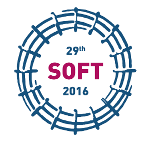Speaker
Chun Kung
(Plasma Physics Laboratory)
Description
Experimental results have shown that twelve-strap HHFW operating at 30 MHz can provide significant plasma heating for NSTX. In this case, it is important to understand the interactions between return currents on the antenna enclosure sidewalls/septa and the launched k|| spectra. CST Microwave Studio is applied to this problem with the view toward optimizing the antenna coupling to the desired spectra.
Two original NSTX antenna structures, each of which includes a single feedthrough strap and its enclosure with Faraday shield, were simulated in a test stand environment. The test stand itself is a small stainless steel vacuum chamber that accommodates two antenna structures. When they were driven out-of-phase with a 0.8-sec 60-kW pulse, the infrared camera images, which imply the return currents via ohmic heating, indicate very good agreement with the simulation results for current distributions on Faraday shields.
With this validation for the model, new simulations have been designed to understand the current distribution on the plasma surface by placing a copper or a stainless steel plate 5 cm away in front of the straps to mimic the plasma. Then these two antenna structures were driven out-of-phase and in-phase to show the induced current patterns on the plate. Two Faraday shield designs were used in the simulations. One has side walls that extend out to near the radius of the current straps and another has side walls that are slotted well back from the current strap radius. The simulation results clearly indicate that the interactive areas on the plate simulating the plasma surface are reduced when there are shallow slots on the enclosure side walls. This suggests that the excitation spectrum is strongly affected in the shallow slot case and hence there is likely a reduction in coupling to the desired waves in plasma as well.
Co-authors
Christopher Brunkhorst
(Plasma Physics Laboratory, Princeton University, Princeton, New Jersey, United States)
Chun Kung
(Plasma Physics Laboratory, Princeton University, Princeton, New Jersey, United States)
Joel Hosea
(Plasma Physics Laboratory, Princeton University, Princeton, New Jersey, United States)
Robert Ellis
(Plasma Physics Laboratory, Princeton University, Princeton, New Jersey, United States)
Rory Perkins
(Plasma Physics Laboratory, Princeton University, Princeton, New Jersey, United States)

